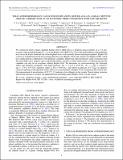WHAT ASTEROSEISMOLOGY CAN DO FOR EXOPLANETS: KEPLER-410A b IS A SMALL NEPTUNE AROUND A BRIGHT STAR, IN AN ECCENTRIC ORBIT CONSISTENT WITH LOW OBLIQUITY
Author(s)
Van Eylen, V.; Lund, Mikkel N.; Aguirre, V. Silva; Arentoft, T.; Kjeldsen, H.; Albrecht, Simon H.; Chaplin, William J.; Isaacson, Howard; Pedersen, M. G.; Jessen-Hansen, J.; Tingley, B.; Christensen-Dalsgaard, J.; Aerts, C.; Campante, T. L.; Bryson, Stephen T.; ... Show more Show less
DownloadEylen-2014-What asteroseismolog.pdf (1.837Mb)
PUBLISHER_POLICY
Publisher Policy
Article is made available in accordance with the publisher's policy and may be subject to US copyright law. Please refer to the publisher's site for terms of use.
Terms of use
Metadata
Show full item recordAbstract
We confirm the Kepler planet candidate Kepler-410A b (KOI-42b) as a Neptune-sized exoplanet on a 17.8 day, eccentric orbit around the bright (K p = 9.4) star Kepler-410A (KOI-42A). This is the third brightest confirmed planet host star in the Kepler field and one of the brightest hosts of all currently known transiting exoplanets. Kepler-410 consists of a blend between the fast rotating planet host star (Kepler-410A) and a fainter star (Kepler-410B), which has complicated the confirmation of the planetary candidate. Employing asteroseismology, using constraints from the transit light curve, adaptive optics and speckle images, and Spitzer transit observations, we demonstrate that the candidate can only be an exoplanet orbiting Kepler-410A. We determine via asteroseismology the following stellar and planetary parameters with high precision; M [subscript *] = 1.214 ± 0.033 M ☉, R [subscript *] = 1.352 ± 0.010 R ☉, age =2.76 ± 0.54 Gyr, planetary radius (2.838 ± 0.054 R ⊕), and orbital eccentricity (0.17[+0.07 over -0.06]). In addition, rotational splitting of the pulsation modes allows for a measurement of Kepler-410A's inclination and rotation rate. Our measurement of an inclination of 82.5[+7.5 over -2.5] [°] indicates a low obliquity in this system. Transit timing variations indicate the presence of at least one additional (non-transiting) planet (Kepler-410A c) in the system.
Date issued
2014-02Department
Massachusetts Institute of Technology. Department of Physics; MIT Kavli Institute for Astrophysics and Space ResearchJournal
Astrophysical Journal
Publisher
Institute of Physics/American Astronomical Society
Citation
Van Eylen, V., M. N. Lund, V. Silva Aguirre, T. Arentoft, H. Kjeldsen, S. Albrecht, W. J. Chaplin, et al. “WHAT ASTEROSEISMOLOGY CAN DO FOR EXOPLANETS: KEPLER-410A b IS A SMALL NEPTUNE AROUND A BRIGHT STAR, IN AN ECCENTRIC ORBIT CONSISTENT WITH LOW OBLIQUITY.” The Astrophysical Journal 782, no. 1 (January 21, 2014): 14. © 2014 American Astronomical Society.
Version: Final published version
ISSN
0004-637X
1538-4357